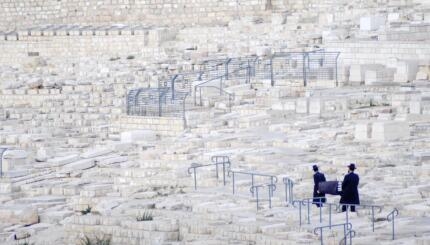Excerpted with permission from Finding Each Other in Judaism (UAHC Press).
In the absence of spiritual and moral rationale, rituals are frequently performed without spirit and meaning. A folk proverb observes: “Wisdom is often hidden under a ragged cloth.” Asking questions helps ritual regain meaning.
Why are so many rites surrounding the funeral austerely simple? Why the plainness of the casket, the dress of the deceased, even the discouragement of flowers? In a profoundly moving passage found in the (Moed Katan27b),the Sages remind us of the history of ritual customs and the ethics of mourning and of the funeral. In an early era, they explain, the expense of the burial was great, and the burial fell harder on the next of kin than his own death. So, the dead man’s next of kin frequently abandoned the deceased. The kinsmen of the deceased fled, embarrassed.
Rabban Gamliel came forward and, disregarding his own dignity, ordered that he be dressed in simple linen cloth instead of woolen, expensive vestments when the time came for his funeral. Thereafter, the people followed his lead to dress their deceased in modest linen clothing. As a result of Rabban Gamliel’s example, a series of funeral reforms took place due to a desire to respect the poor. Formerly, the rich would be brought out for burial on ornamental, tall, stately beds covered with rich coverlets, while the poor were placed on a plain bier, a box. The poor felt ashamed, and mipnei kavodan shel aniyim, “out of respect for the poor,” the Rabbis instead insisted that all deceased should be buried in a plain box (ibid.).

Help us keep Jewish knowledge accessible to millions of people around the world.
Your donation to My Jewish Learning fuels endless journeys of Jewish discovery. With your help, My Jewish Learning can continue to provide nonstop opportunities for learning, connection and growth.
Similarly, in earlier times, the face of the rich deceased was left uncovered, while the face of the poor deceased was covered, because the faces of the poor who lived in years of famine turned livid. The poor felt shamed to the point of abandoning the deceased, and therefore a tradition was instituted that everybody’s face should be covered. This reform too was based on the reiterated principle “out of respect for the poor” (ibid.).
The mourning ritual embodies strong ethical lessons. Ostentatious funerals are not considered appropriate. Flowers at the funeral are discouraged, not as a principle of aesthetics, but of ethics. The memory of the deceased is enhanced when money that would purchase bowers of flowers is given to add fragrance to the life of the sick or the poor. We honor the dead by elevating the living. In death as in life, the ethics of the tradition instructs us to love merry and to walk modestly with God.
Working out grief calls the mourner to recite the for a period of 11 months. We hold on. But there is a limit set to mourning. To sit shiva beyond seven days or to recite Kaddish beyond 11 months is deemed excessive. And in excessive mourning, the Rabbis observe, one is no longer mourning for the deceased but for someone or something else, perhaps oneself. When our impulse is to hold on, Jewish mourning practice instructs us and encourages us to let go.
Sign up for a Journey Through Grief & Mourning: Whether you have lost a loved one recently or just want to learn the basics of Jewish mourning rituals, this 8-part email series will guide you through everything you need to know and help you feel supported and comforted at a difficult time.
Looking for a way to say Mourner’s Kaddish in a minyan? My Jewish Learning’s daily online minyan gives mourners and others an opportunity to say Kaddish in community and learn from leading rabbis.


